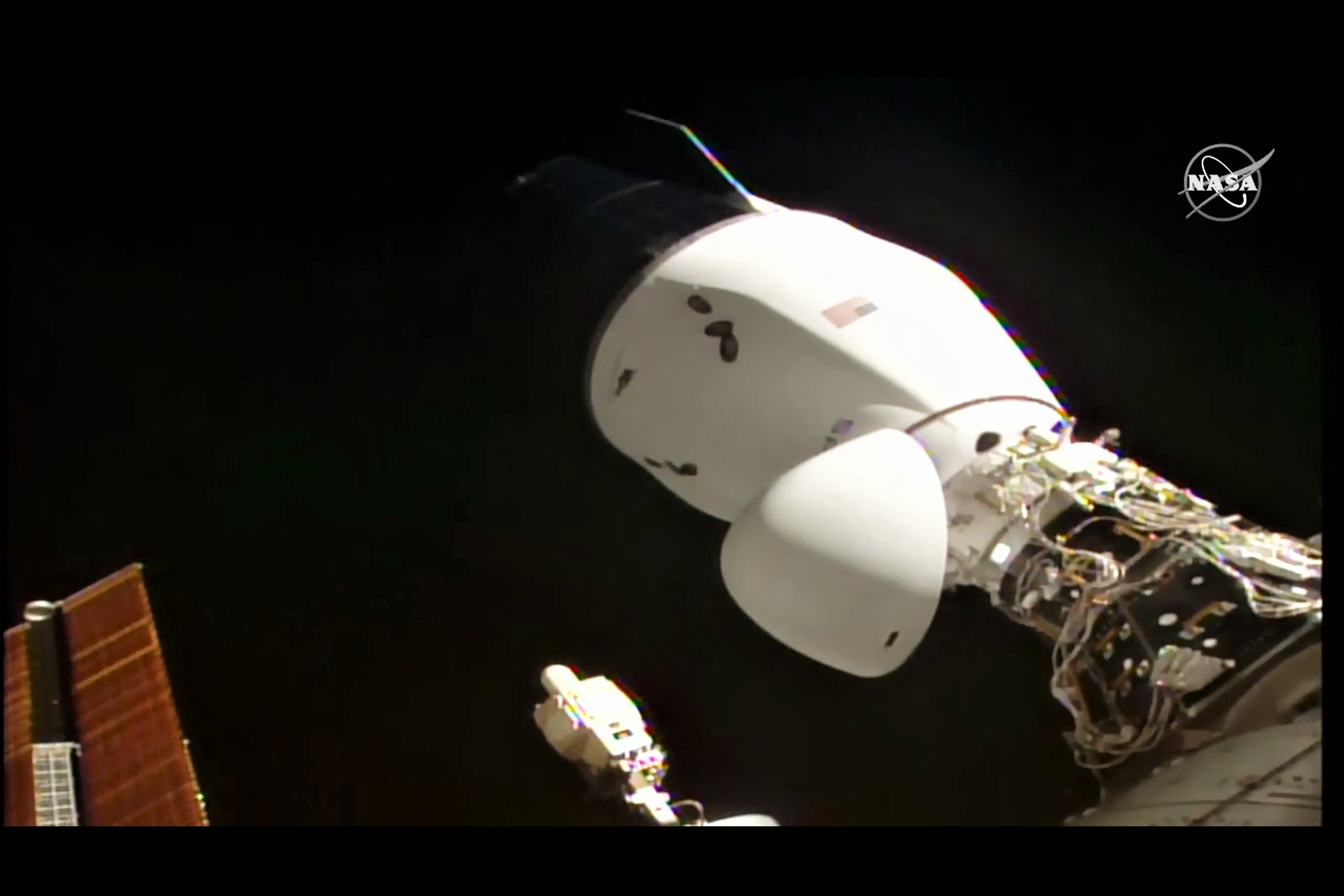
Ken Kremer – For SpaceUpClose.com & RocketSTEM
KENNEDY SPACE CENTER, FL – The first of the next generation SpaceX Cargo Dragon supply ships successfully docked at the International Space Station (ISS) today, Dec. 7, as the two vehicles were traveling 268 miles over the southern Indian Ocean at 17, 500 mph – just over 26 hours after the flawless and fantastic blastoff on a Falcon 9 rocket into gorgeous Sunday lunchtime skies over Florida’s Space Coast – on a NASA contracted delivery run hauling over 3 tons of NASA science and supplies and a new commercial airlock from Nanoracks to enhance research capabilities to the seven person multinational crew living and working on board.
The SpaceX Dragon cargo spacecraft performed the first ever autonomous rendezvous and docking of a Dragon cargo spacecraft to the ISS by SpaceX.
Dragon docked to the space-facing (zenith) port of the orbiting laboratory’s Harmony module for the first time at 1:40 p.m. EST (1840 GMT), Monday, Dec. 7, about 26 hours after liftoff and remain at the station for about 35 days.
The @SpaceX #Dragon docked to the Harmony module's space-facing port at 1:40pm ET today where it will stay for one month. More… https://t.co/7z5T8AFyuG pic.twitter.com/75rQEwxTFP
— International Space Station (@Space_Station) December 7, 2020
The zenith docking port is located adjacent to and perpendicular to the Crew Dragon vehicle that arrived last month with the four person Crew-1 astronaut team who will remain aboard the station for a six-month science stint.
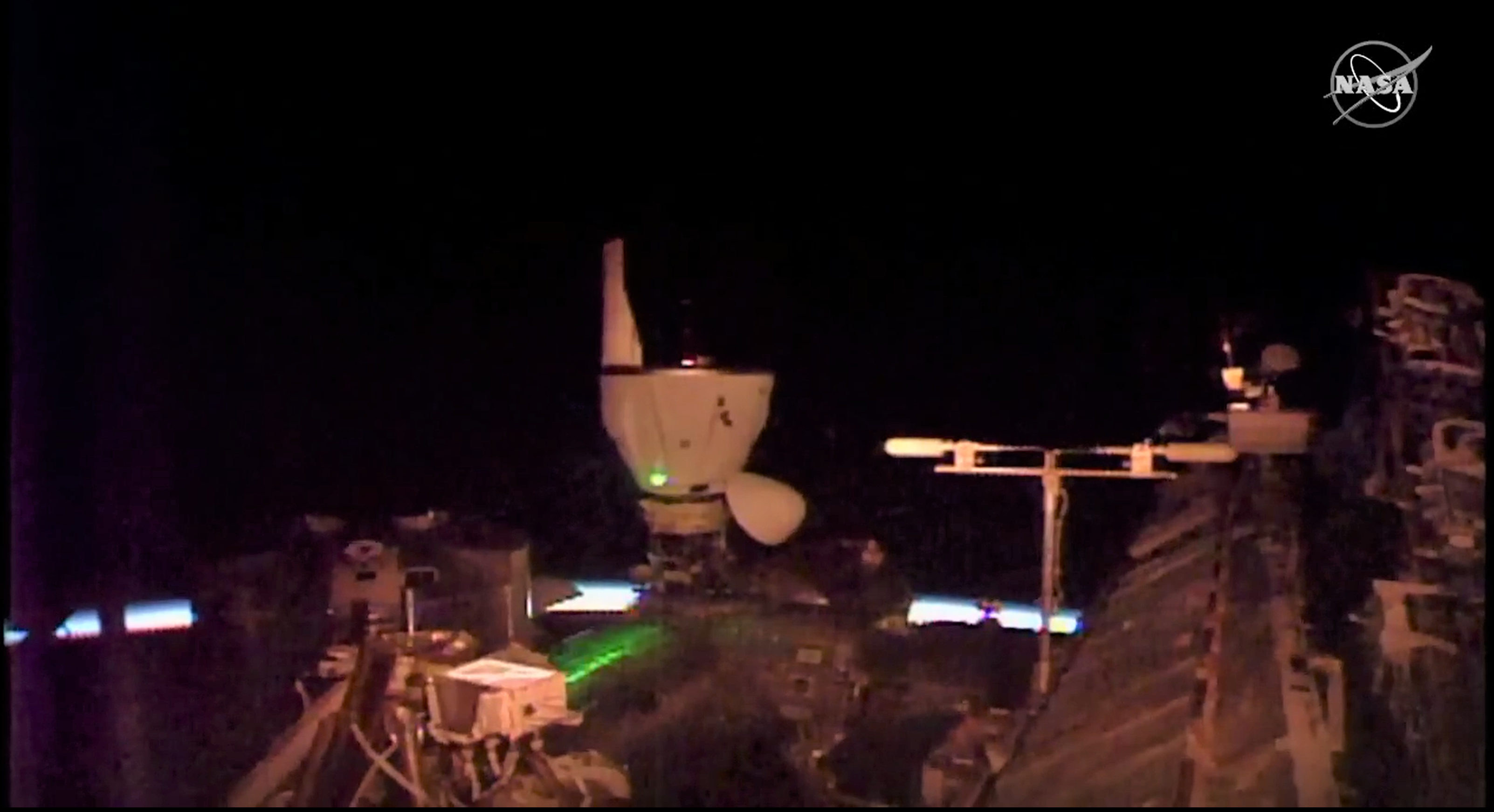
NASA astronauts Kate Rubins and Victor Glover monitored Cargo Dragon’s approach, rendezvous and docking operations today.
Watch this cool time-lapse of the Dragon approach:
Time-lapse of Dragon on approach – two Dragons now docked to the @space_station pic.twitter.com/I046jBmC7o
— SpaceX (@SpaceX) December 8, 2020
The duo will also be readying the Tranquility module for Dragon’s primary payload, the NanoRacks Bishop science airlock.
NASA TV offered several hours of live coverage and commentary.
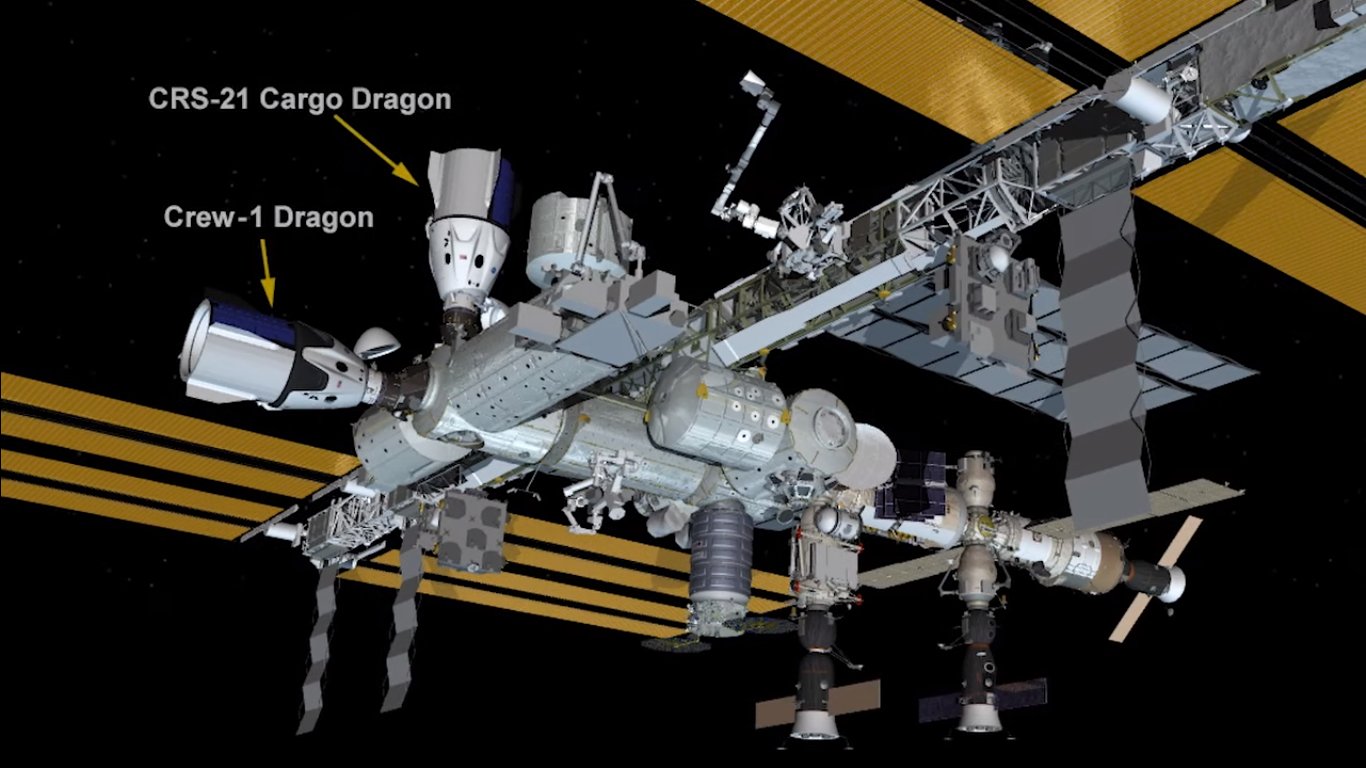
Cargo Dragon launched on a veteran 4x recycled ‘flight-proven’ Falcon 9 on the 21st Commercial Resupply Services mission, dubbed CRS-21, to the International Space Station, under the auspices of NASA’s commercial cargo program.
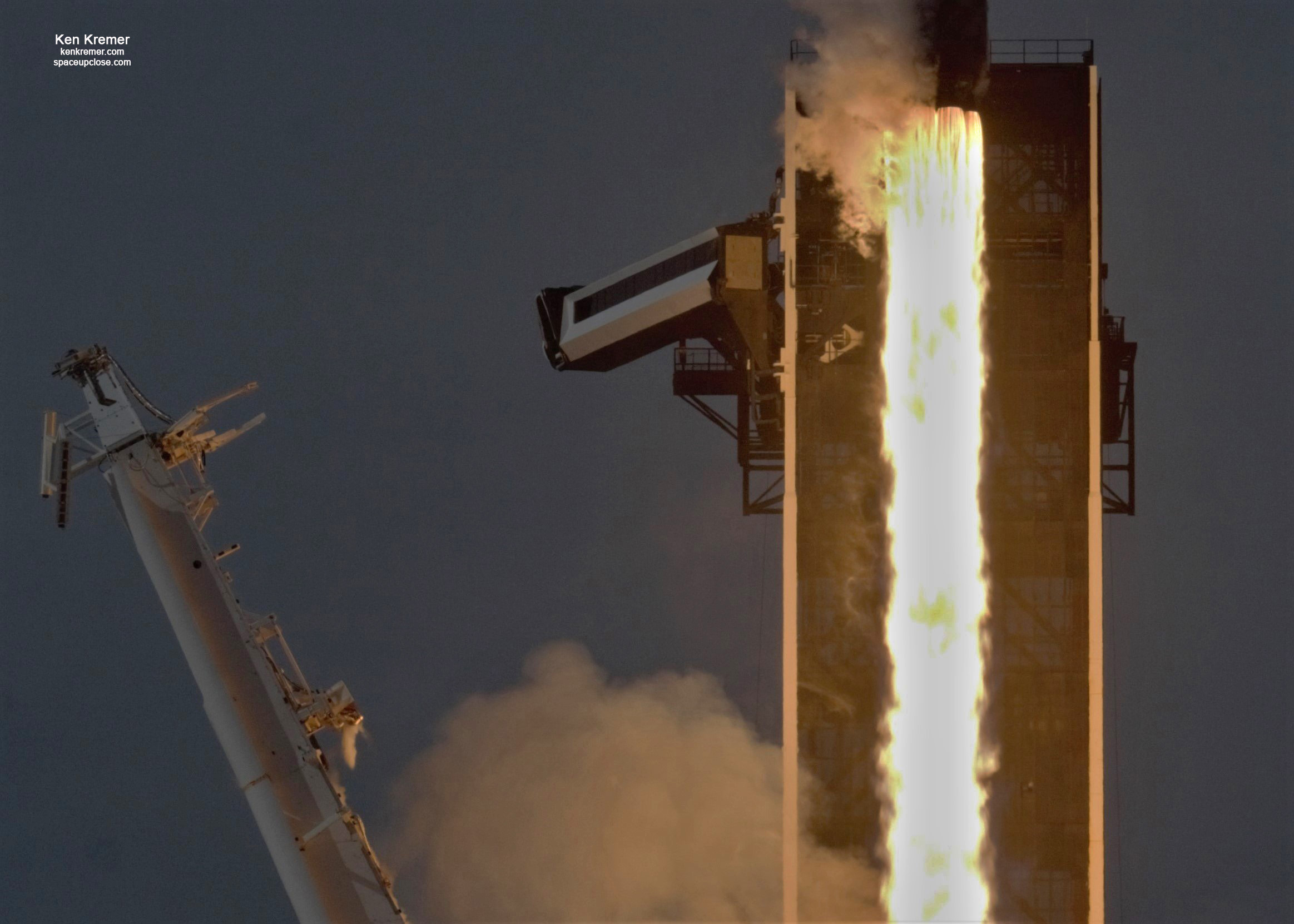
Liftoff of the SpaceX Falcon 9 rocket carrying the Cargo Dragon supply ship on the CRS-21 resupply mission to the ISS took place at 11:17 a.m. EST (1617 GMT), Sunday, Dec. 6, from seaside Launch Complex 39A on NASA’s Kennedy Space Center (KSC) in Florida.
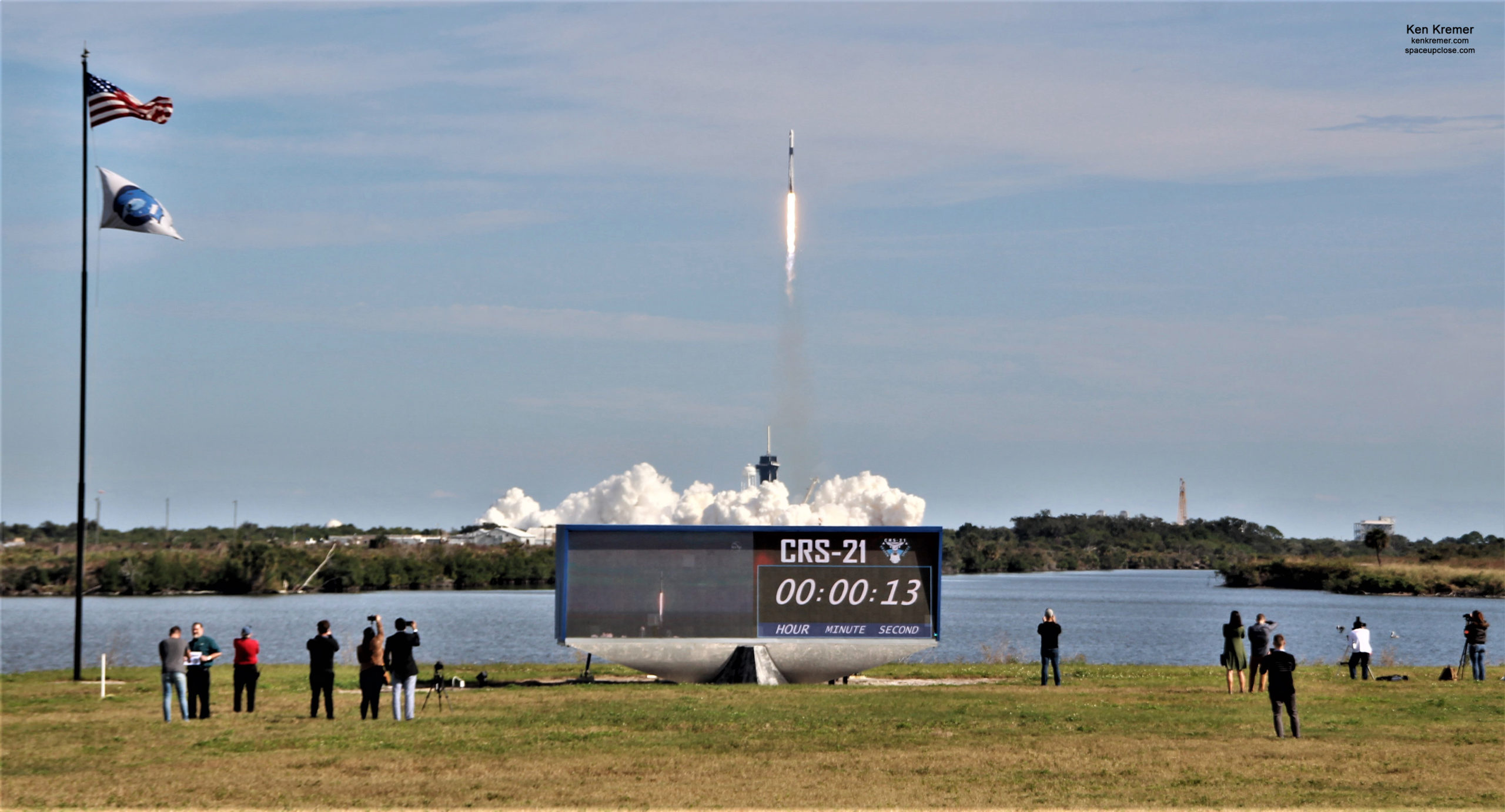
Among the science experiments are using microbes to mine asteroids, examining how changes in gravity affect the heart at the cellular and tissue level on tissue chips and the effect of microgravity on brain organoids, as well as the commercial Nanoracks airlock filling nearly the entire exterior cargo volume in the Dragon trunk section.
The privately funded Nanoracks Bishop Airlock is a new commercial platform 5 times bigger than the Japanese airlock on the Japanese Experiment Module (JEM) already in use. It will vastly increase the ability to deploy more cubesats and house externally mounted research payloads.
SpaceX tweeted a stunning view of the separation showing the commercial Nanoracks airlock filling nearly the entire exterior cargo volume
Dragon separation confirmed; the spacecraft is on its way to the @space_station. Autonomous docking tomorrow at approximately 1:30 p.m. EST pic.twitter.com/NJhm7q7PP7
— SpaceX (@SpaceX) December 6, 2020
Enjoy our Space UpClose launch and prelaunch photos of the SpaceX Falcon 9 and Cargo Dragon from pad 39A from onsite at the Kennedy Space Center (KSC) from the team of Ken Kremer and Jean Wright
NASA SpaceX CRS-21 is actually a mission of many firsts:
The flight also marks the first time two Dragon will be docked to the ISS – including the SpaceX Crew 1 Crew Dragon Resilience that arrived in November. It will also be the first cargo Dragon to splash down in the Atlantic Ocean vs. the Pacific Ocean.
🚀 The @SpaceX resupply mission launching Sat., Dec. 5 will make history for many firsts, including the first time 2 Dragon spacecraft will be docked to the @Space_Station, & the first cargo Dragon to splash down in the Atlantic: https://t.co/PJGMhAsM58
Get to know more ⤵️⤵️⤵️ pic.twitter.com/1IemIuX1Rq
— NASA (@NASA) December 5, 2020
CRS-21 delivers some 6,553 pounds (2,972 kg) of supplies, equipment, and critical materials needed to support a variety of science and research investigations that will occur during Expeditions 64 and 65.
The total pressurized cargo is 4150 pounds (1882 kg).
The unpressurized payload comprising the Nanoracks Bishop commercial airlock is 2403 pounds (1090 kg) stowed in the trunk section.
The Nanoracks Bishop Airlock “is a commercial platform that can support a variety of scientific work on the space station. Its capabilities include deployment of free-flying payloads such as CubeSats and externally-mounted payloads, housing of small external payloads, jettisoning trash, and recovering external Orbital Replacement Units. Roughly five times larger than the airlock on the Japanese Experiment Module (JEM) already in use on the station, the Bishop Airlock allows robotic movement of more and larger packages to the exterior of the space station, including hardware to support spacewalks.”
The airlock will be installed onto an open common berthing mechanism CBM on the Tranquility module Node 3 by astronauts using the SSRMS robotic arm.
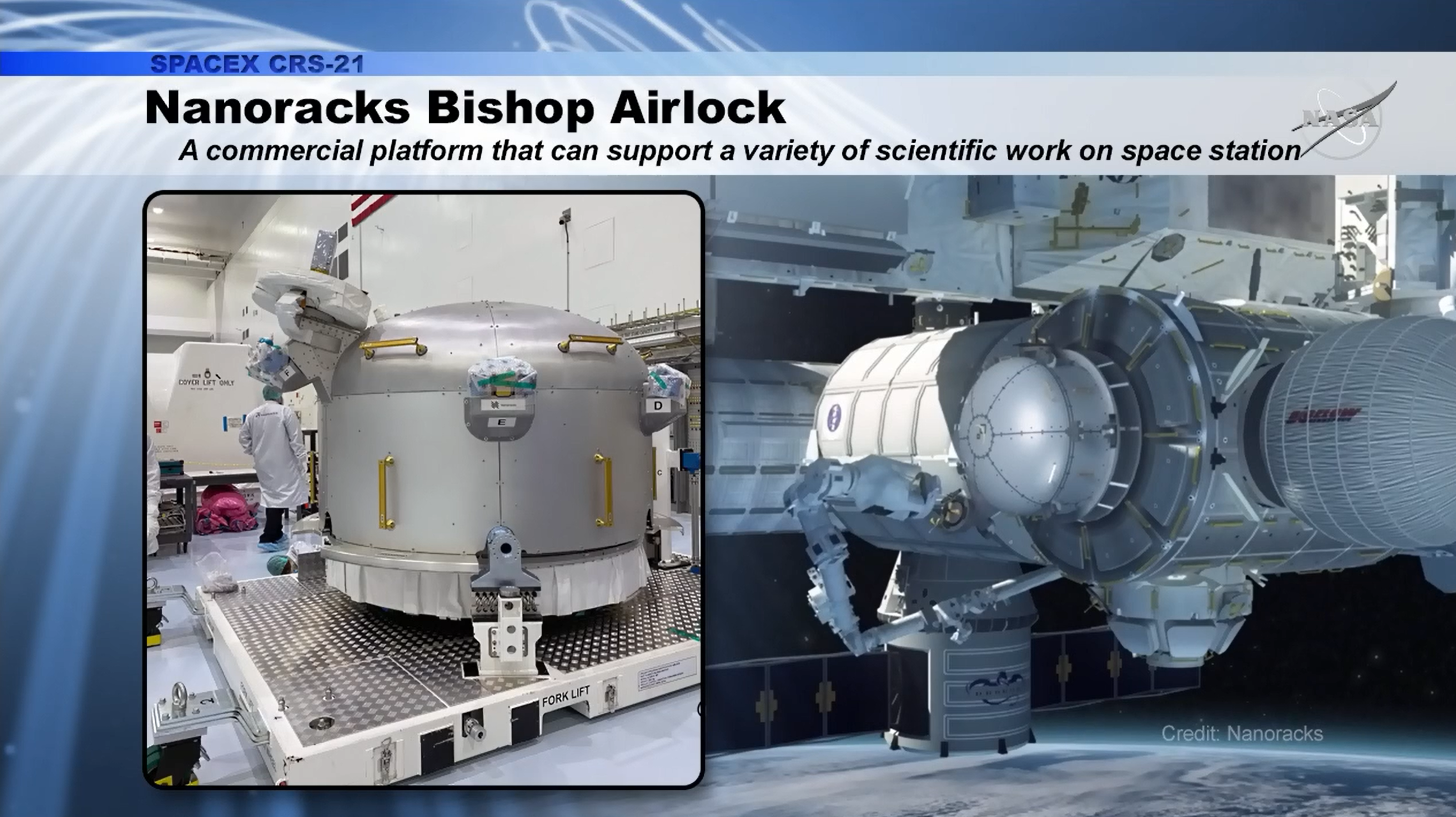
This NASA graphic shows the CRS-21 mission cargo manifest
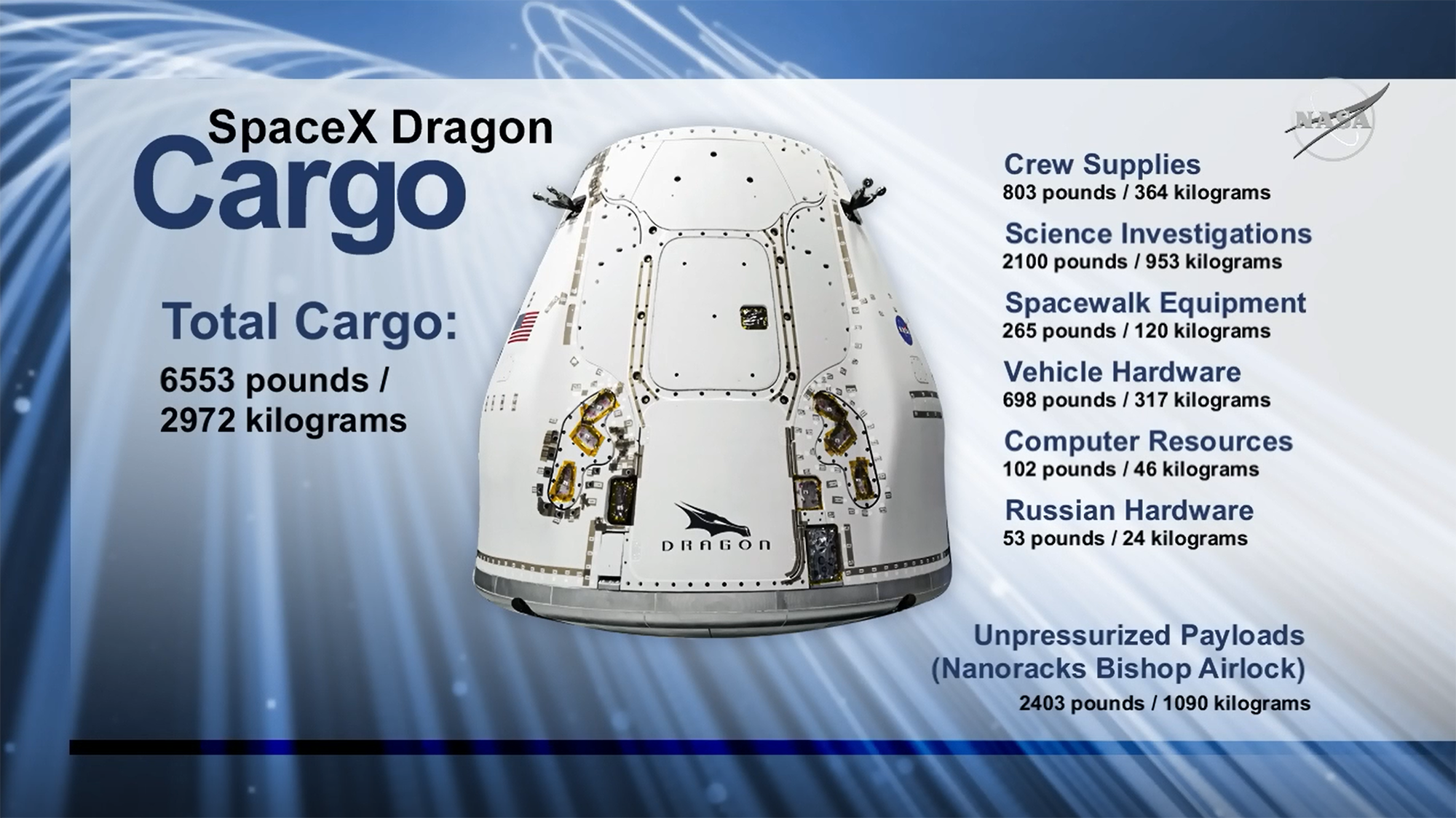
NASA describes some of research on board: The science being delivered on this mission includes a study aimed at better understanding heart disease to support development of treatments for patients on Earth, research into how microbes can be used for biomining on asteroids, and a tool being tested for quick and accurate blood analysis in microgravity. The first commercially owned and operated airlock on the space station, the Nanoracks Bishop Airlock, arrives in the unpressurized trunk of the Dragon cargo spacecraft. Bishop will provide a variety of capabilities to the orbiting laboratory, including CubeSat deployment, and support of external payloads.
Watch my Dec 7 interview on WFTV Ch 9 ABC News Orlando about launch of upgraded Crew Dragon to ISS and about the significance of the commercial research Bishop airlock provided by Nanoracks:
“Second SpaceX Dragon spacecraft docks at ISS”
https://www.wftv.com/video/?id=164c52d1-0615-42e0-8095-758b289b678c
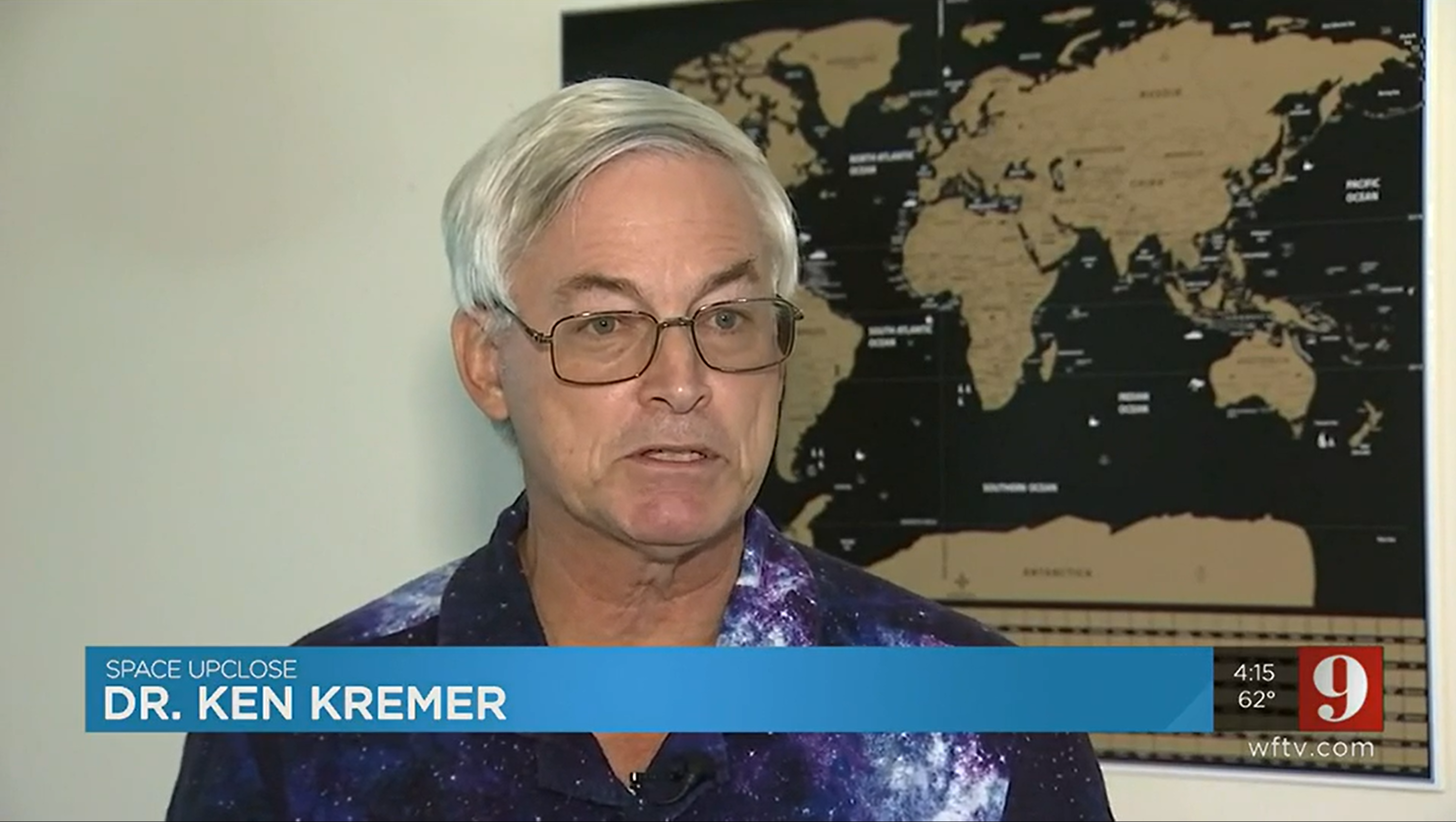
My interview about competitor Sierra Nevada Corp Dream Chaser space plane resupply mission to ISS featured on Spectrum News 13 Orlando on Dec 4.
Watch Ken’s continuing reports about SpaceX Cargo and Crew Dragons, Starlink, Commercial Crew and Artemis and onsite for live reporting of upcoming and recent SpaceX and ULA launches including Crew-1, Starlink, X-37B, Solar Orbiter, Mars 2020, NRO spysats and more at the Kennedy Space Center and Cape Canaveral Space Force Station.
Stay tuned here for Ken’s continuing Earth and Planetary science and human spaceflight news: www.kenkremer.com –www.spaceupclose.com – twitter @ken_kremer – email: ken at kenkremer.com
Dr. Kremer is a research scientist and journalist based in the KSC area, active in outreach and interviewed regularly on TV and radio about space topics.
………….
Ken’s photos are for sale and he is available for lectures and outreach events
Please consider supporting Ken’s work by donating at Patreon:
https://www.patreon.com/kenkremer
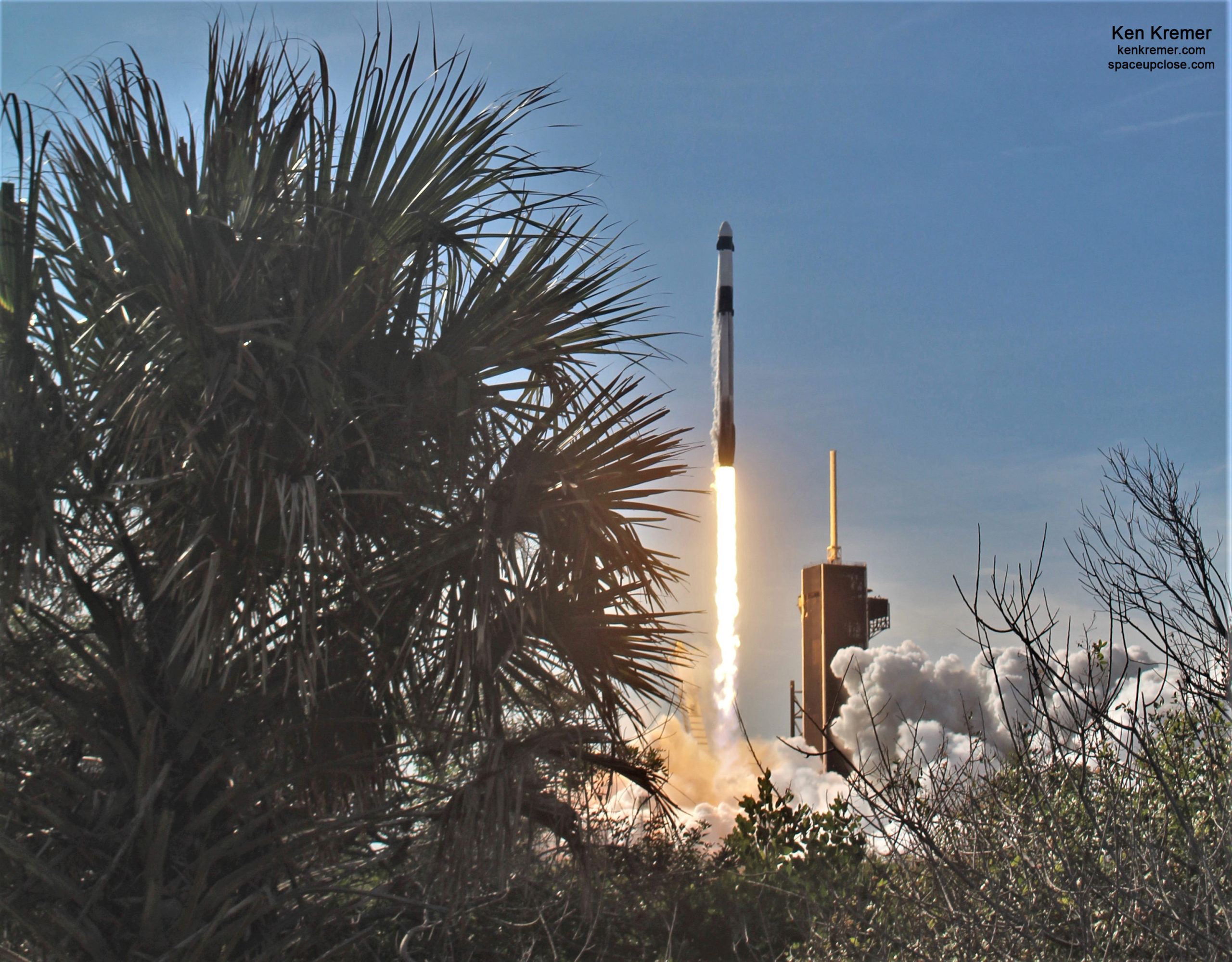
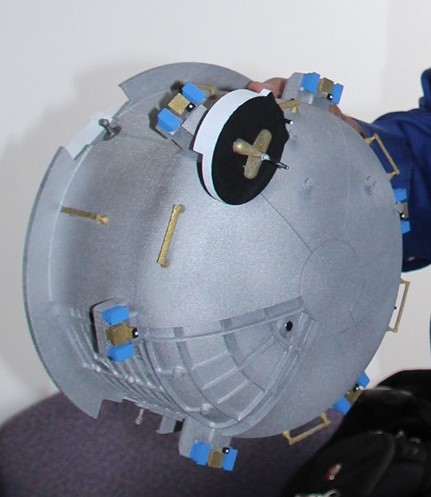
x



